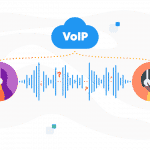Top 6 Communication Channels to Grow your Business

To get new customers, the first step is to communicate with them in some way – through writing, videos or calls in some shape. Instead of finding ways to adjust their communication styles, many businesses today focus on fancy growth tactics that often lead to nowhere.
Instead, take a step back and think about the way you communicate – both with your customers and with your employees. Small and subtle changes can make a major impact on your bottom line and your employee satisfaction.
In today’s article, let’s explore the best communication channels you can use to grow your business, with new customers and by making your employees more engaged and satisfied.
What are communication channels?
Communication channels are the means of communication used to convey specific messages.
Examples of communication channels are social media, email, telemarketing, instant messaging apps, or even face-to-face interactions.
Communication channels are vital for a business because they allow people to connect and engage with one another. They also provide a way for businesses to reach new customers and stay in touch with their employees on a regular basis. Moreover, they often can play a crucial role in the success of your business.
Picking the right communication channel for your company will depend on the purpose of the message and its target audience.
Give your customer service agents the tools they need to succeed with CloudTalk.
How do I choose the right communication channels?
It depends on quite a few factors, it really boils down to your specific needs and what you’re trying to achieve. With that in mind, we’ve prepared some handy tips that will help you with this task.
Think about the type of your messages regarding your audience
The first thing you should consider is the type of message and audience. Try asking yourself the following questions:
- What are you trying to communicate? Is it formal or informal?
- Do the customers or employees need to see the message in a specific time frame?
- Is it necessary to deliver a message to your team or to the whole company?
- Does this communication need a response or not?
- Are you communicating with one person or a group of people?
Doing so will help you choose the right tone of voice to match the message and make it more engaging for your audience.
Consider your company values, available resources, and the appropriate delivery methods
Moving on, you should ensure that the potential communication channels align with your company’s culture and values.
For example, if you run a SaaS company offering communication software, a good idea would be to use your own tool as one of the communication channels – in the case that you’re communicating with your employees.
This will not only be very convenient as you most likely know this channel well, but it will also show other people that your product is very reliable and it has a practical application in real life.
However, most companies don’t have their own custom tools. What you should do in this case is think about how you would like your specific company to be contacted by others. Spend some time also thinking about how you’d like your employees to interact with each other.
Moreover, if your company values teamwork and perfect collaboration, your decisions in regard to your communication channels should also reflect that.
Pick suitable communication channels for your audience
Last but not least, you’re going to want to pick those communication channels that will be appropriate for the people that you want to send and/or exchange messages with.
Is it your customers, your employees, your clients, or maybe someone else? For example, video conferencing may be an excellent platform for communicating with your team, but not so much with customers who just want their problems solved on the first call.
Once you have the answer to these questions, you’re ready to begin your hunt.
Here are some general rules when choosing specific communication channels tailored to your business:
- Check out the reviews, for example, on Capterra.
- Ask your employees which way of communication suits them best.
- Do some research to find out which of your existing channels get used the most by your customers and your own team internally.
- Think about what your budget is and try to find solutions that you can easily afford.
- Consider consulting with your employees to see if they’d like to try a specific tool out.
- Take a look at the available features of tools and decide whether you’ll use them or not.
- Find out what’s working for your competition.
- Do some research to see how effective particular communication channels in general are.
Following this guide should allow you to prepare to choose the right tools for communicating with other people. Depending on your goals and your target audience, you can choose the best one for your specific scenario.
Here are some recommendations to help you out.
The three best communication channels for teams
Effective teamwork is vital for a company’s success. Different teams prefer different channels and ways of communication. If you want to get the most out of each of your departments, try to take these preferences into consideration and create an efficient communication strategy.
#1 In-person communication
The benefits of face-to-face communication are many and varied, but there is one that is the most prominent: the ability to read the other person’s nonverbal cues. These cues often tell us where we stand with someone, how we should respond to what they’ve said and done, and what our next move should be.
The pandemic has changed quite a few things, and in-person communication has become less common. Thanks to this, 61% of people have started using new communication tools since the pandemic started. Despite that, 33% of people consider that communication has become more challenging.
There are plenty of studies that have been conducted on the subject of face-to-face communication. Many of them state that at least 70% of communication between people is nonverbal. Depending on the specific research, this number can vary from 70% up to 93%!
Considering this, it’s easy to come to a conclusion that people who communicate through other channels such as text messaging, emailing or video calling simply may miss out on this vital aspect of non-verbality.
They don’t get any social cues such as tone of voice or facial expressions. This means that their communication can become ineffective or even detrimental.
Because of this, an important and productive communication channel that could prevent that ineffectiveness and damage within your teams is face-to-face communication.
How can you work using professional face-to-face communication?
There are many methods you could use to implement face-to-face communication within your workplace, and here are some examples:
- regular conferences
- morning meetings
- quick chat sessions throughout the day
- in-person brainstorm meetings
Below we have some benefits and drawbacks of this communication method to test if you implement it.
Benefits of face-to-face communication
- It increases team engagement and productivity
- It creates a fast communication channel
- It is 34 times more effective compared to email communication
- It allows for nonverbal interactions
- It comes at a low cost of facilitating a meeting if you already have office space available to use
Drawbacks of in-person communication
- It can create possible language barriers
- It may be difficult or impossible in the case of virtual or international teams
- It is almost impossible during a lockdown and remote work
- It may be unsuitable for large teams as getting a message across to huge gatherings is challenging due to the missing personal touch
- It comes with possible poor retention by the listener
While it does have its drawbacks, in-person communication should be your go-to choice if you have the option of seeing your coworkers every day.
#2 Video conferencing
Moving on, we have video conferencing, which gained a lot of popularity when the world was hit with the pandemic, and many employees were forced to switch to remote work.
Video conferencing is somewhat similar to face-to-face interaction. Just like with in-person communication, it allows people to see and hear each other. However, because it takes place in the virtual world, there are other benefits, as well as some drawbacks, stemming from this type of communication, with teams.
But before we tell you what those are, let’s first look at some important numbers:
- Within the first four months of the COVID-19 pandemic, there was a 500% increase in search impressions for web and video conferencing software.
- The video conferencing market is expected to surpass $75 billion by 2027.
- 67% of companies planned to spend more on web & video conferencing in 2021.
Pros and cons of video conferencing
We’ve compiled a table that summarizes the key pros and cons of video conferencing that you might consider when you decide whether or not to implement it as part of your team communication strategy.
PROS
- More engaging than audio conferencing as it adds a more personal touch thanks to the presence of cameras
- improved quality of communication compared to audio conferencing – according to 62% of executives in one research
- Improves team productivity
- Saves time and logistics’ hassle
CONS
- Not as engaging as face-to-face interaction
- Not accessible to everyone (camera, microphone, and so on)
- It can be challenging in case of connection issues (which usually can be easily resolved, but not always)
- It may be difficult for some to focus on their work with this type of communication (but the adaptation to it is quick)
- Could be complicated in terms of international teams, traveling, and different time zones
If you have the capacity in your organization for video conferencing to take place, we definitely recommend it as a communication channel for teams. It’s more convenient, it’s cheaper and if you work remotely and don’t have an office, it’s practically the only choice you have.
#3 Online messaging platforms
Finally, we have the least ‘personal’, but still effective, communication method, online messaging platforms. Since the invention of online messaging platforms such as Skype, people have been able to have conversations with team members over the internet. With Skype no longer an option, many are porting their Skype numbers.
These days, many businesses rely on these platforms for their daily communication needs. Some large companies even choose to use these platforms as their primary means of communication.
When we go to Capterra and type in ‘online messaging for teams’, we get more than 10,000 different results for products.
That’s a lot, and we can only imagine how overwhelming it could be for you to have to go through this to pick the best solution for your teams.
We can, however, give you some tips on what factors you should pay attention to when choosing the best online messaging platform:
- price
- variety of features
- compatibility with different devices and software
- ease of use
- reviews
Knowing what your specific needs and requirements are will make it much easier for you to pick the right online messaging platform. As a result, your teams will be able to enjoy their job more and provide fruitful results of their work.
Three best communication channels for customers
Now that we’ve covered the top communication channels for teams, let’s move our focus towards our customers.
#1 Phone calls
Phone calls are a great way to connect with customers and offer them a human-to-human connection, even though it’s over a phone line. The importance of making a great first impression cannot be overstated, and this is where phone calls and call center agents can come in handy.
Moreover, this communication method offers a more personal way of connecting with others, compared to live chats for example. This is because with phone calls, it may be much easier to understand people’s tone of voice. Using the phone for sectors like logistics or hospitality could lead to faster understanding between a customer and an agent compared to communication via email.
If you’re looking at how you can put in place an effective communication channel with your customers, phone calls and call centers are the way.
The call center industry caters to many businesses across various markets. Moreover, phone calls are great for creating a positive consumer experience and building brand loyalty.
Key call center statistics:
- The global market for call centers is expected to reach $496 billion by 2027.
- 76% of customers who contact customer service do so over the phone.
- Compared to on-premise contact centers, cloud contact centers are 27% cheaper and experience 35% less downtime.
Thanks to the constantly developing technologies, such as callback and interactive voice response (IVR) features, today’s call centers are even more effective and enjoyable than before. A bonus: the pricing for IVR and other handy features becomes more and more affordable with the technology development.
When you look at solutions like CloudTalk, which is the perfect tool for sales and customer service teams, other features that you can expect to see include:
- call queuing
- call recording
- skills-based routing
- automatic outbound caller ID
- call forwarding
- click to call.
In fact, there are many more features that a reliable call center provider could offer. For this reason, we definitely recommend checking different variations out.
Despite many modern platforms being developed, calls still remain one of the most effective ways of getting in touch. When you consider all the modern call center features, it only makes sense to use calls as a part of your communication strategy.
#2 Live web chat
Next, we’ll talk about live web chat.
Online live chats are a form of communication in which your consumers and your company representatives can talk online. Such communication usually takes place in real-time by exchanging written messages.
This is a great way to build rapport between the customer and the company.
It also helps in conveying information more clearly than via phone conversations or email, which can sometimes be misinterpreted or forgotten, especially if calls aren’t recorded.
Live chats are very cost-effective too, so it is no wonder that they are becoming more popular among companies.
If that isn’t convincing enough, think about how direct, personal, and interactive this communication channel can be. All you need to add is some customization, engaging features and that’s it.
They also allow consumers to enjoy a more seamless experience, as they don’t usually have to wait a long time for a response.
This can be especially helpful when dealing with customers that are newbies or those who are interested in exploring your site. And that’s because they might need more guidance on what they should do next. They can also help in effective lead generation.
The live chat conversation is also archived and can be used as evidence in the future if the customer has any complaints about the customer service they received from the company.
Other great benefits of live chat software include transparency and authenticity, all by providing a one-stop shop for customers. Don’t let yourself miss out on this great communication channel.
#3 Social media
Furthermore, if a lot of your customers are Millenials and Gen Z, then social media could be one of the best communication channels you could pick to get in touch with them.
We have come a long way from just communicating verbally, but it is only recently that we have started using social media as a mode of communication with consumers. Videos have emerged as one of the most popular and versatile forms of content due to their ease of consumption, accessibility of marketing video guides, and their ability to convey storytelling, product demonstrations, testimonials, and behind-the-scenes glimpses. This multimedia format enhances consumer engagement, providing a more immersive experience, especially on social media. Businesses can leverage social media report examples to analyze consumer engagement and improve their marketing strategies.
With the ever-increasing popularity of smartphones and social media platforms, consumers are now more connected than ever before – and brands are taking notice.
Key statistics:
- When customers’ social media queries get a response from a brand, 74% of millennials say that their perception of that particular brand improves.
- According to 65% of 18-34-year-olds, social media is a good way to provide customer service, while 75% of those aged 55 and older do not believe that social media can be an effective channel.
- 37% of consumers globally expect a response to social media questions or complaints, the same day they send it, with 28% and 18% expecting it within one hour or even immediately respectively.
When it comes to Facebook, there are many interesting customer service solutions that you could implement, such as Messenger AI chatbots.
Not only will you be closer to your customers, but thanks to the chatbot, you will also be able to respond to queries quickly and effectively. For example, using auto-reply for Facebook comments can significantly enhance your consumers’ experience.
Twitter is also a good place to offer customer service, with various companies actively engaging and helping their customers on this platform. Just take a look at this Adobe XD example:
Other social media platforms we recommend that you could use:
- YouTube
- TikTok
Social media platforms are still powerful players in the customer service game, especially when it comes to younger generations and your brand reputation. Don’t sleep on this effective communication channel.
Communication channels in summary
Remember that your chosen communication channel for either your teams or your customer service can have a massive impact on effectiveness and performance.
If you’d like to read similar releases to this one, make sure you check our blog. We talk about topics like customer service, effective workplace strategies, call center features, and more.
And if you’re looking for a reliable solution to deal with your customer service communications, you have to give CloudTalk a try – you won’t regret it!
Elevate your call center with CloudTalk’s customer service features.
























